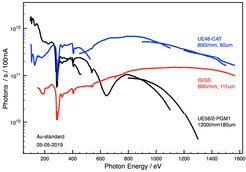New facilities BElChem and CAT@EMIL put into operation at HZB/BESSY II
M.Häveckera, E. Stotz, M. Gorgoib, A. Efimenkob, A. Knop-Gerickea, R. Schlögl
Since 2007, the Fritz-Haber-Institut operates a fixed enstation at the bending magnet based plane grating monochromator (PGM) beamline ISISS (Innovative Station for In-Situ Spectroscopy). An ambient pressure X-ray photoelectron spectroscopy (AP-XPS) instrument equipped with a wide angle acceptance pre-lens is used at this beamline. In May 2018 the undulator based AP-XPS spectrometer has been put into operation as part of the HZB/MPG project BElChem (Berlin joint lab for electrochemical interfaces) that is currently under development at BESSY. This beamline is served by the UE56/2 elliptical undulator of the MPG and combines a high photon flux at low photon energies with an AP-XPS spectrometer without a wide angle acceptance lens but with a high, robust transmission at low kinetic energies and a powerful differential pumping of the electrostatic lens. This set allows a superior performance for valenceband studies and direct in-situ determination of the materials work function by evaluating the position of the secondary electron cut-off. Figure 1 compares the experimentally determined photon flux of the ISISS (red line) with the BElChem beamline (black line) at comparable spectral resolution under standard AP-XPS working conditions at sample position. It becomes apparent that the beamline characteristics of BElChem and ISISS nicely complement each other.

ISISS, BElChem (UE56/2-PGM1), and CAT@EMIL at BESSY dedicated to AP-XPS
spectroscopy.
Also shown in Figure 1 is the photon flux of the soft X-ray branch of EMIL (Energy Materials In-Situ Laboratory Berlin) served by the UE48 undulator at the focus position in the CAT laboratory (red line). It can be seen that the soft EMIL beamline provides a broad photon energy range with a high photon number in the whole energy range. A strategy of commissioning phases combined with user experiments (e.g. within the CRC project cobalt based catalysts in isopropanol oxidation) is applied to put this facility into operation. This station combines an AP-XPS spectrometer equipped with a wide acceptance lens and high kinetic energy capabilities (up to Ekin=7000eV) with a sophisticated laboratory infrastructure optimized for in-situ XPS experiments with a chemical background. The photon energy range will be extended to the tender X-ray regime up to 8000eV by exploiting the radiation of the cryogenic in-vacuum undulator U17 in a second installation phase of this project1,2 in the end of 2019/beginning of 2020, hence providing a perfect match with the spectrometer specification with its broad kinetic energy range.
In summary, while the permanent user operation of the workhorse ISISS is ensured, the new AP-XPS facilities BElChem and CAT@EMIL have been into operation put step by step within the last year. All set-ups are equipped with the modular endstation/reaction cell concept developed at the FHI to optimize flexibility and possibility to adapt the instrumentation to the
user needs.
References:
1. R. Follath, M. Hävecker et. al. B. J. Phys.: Conf. Series 425, 2120003 (2013)
2. S. Hendel, F. Schäfers et al., AIP conference proceedings 1741, 030038 (2016)ù
Affiliations:
a) MPI for Chemical Energy Conversion, Stiftstrasse 34-36, 45470 Mülheim a.d. Ruhr, Germany
b) Helmholtz-Zentrum Berlin/BESSY II, Albert-Einstein-Strasse 15, 12489 Berlin, Germany
